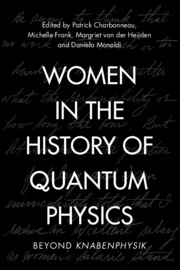Book contents
- Women in the History of Quantum Physics
- Women in the History of Quantum Physics
- Copyright page
- Contents
- Contributors
- Foreword
- Introduction
- 1 The Spectrum of He+ as a Proving Ground for Bohr’s Model of the Atom: A Legacy of Williamina Fleming’s Astrophysical Discovery
- 2 H. Johanna van Leeuwen, the Other Scientist behind the Bohr–Van Leeuwen Theorem
- 3 Hertha Sponer, Maven of Quantum Spectroscopy
- 4 Angular and Career Momentum: What Lucy Mensing Contributed to Physics and Why She Left the Field
- 5 Discouraging Jane: Dewey Among the Lucky Generation of US Physicists
- 6 Laura Chalk and the Stark Effect
- 7 Elizabeth Monroe Boggs: From Quantum Chemistry to the Manhattan Project
- 8 Excelsior! John Wheeler, Katharine Way, and the Role of Women in the Exploration of the Microcosm
- 9 Sonja Ashauer from São Paulo to Cambridge: A Journey to Quantum Electrodynamics
- 10 Untangling Entanglement History: Early Quantum Contributions of Chien-Shiung Wu
- 11 From Quantum Physics to Ethics: Grete Hermann on Heisenberg’s Cut
- 12 Women Take the Lead: A Physics Laboratory Under the Dictatorship in Portugal, 1940s–1960s
- 13 Carolyn Parker’s Electronic Frequencies
- 14 The Chew–Low–Salzman Method and Freda Friedman Salzman: A Physicist Between Nuclear and Social Interactions
- 15 Out of the Ivory Tower: Maria Lluïsa Canut and X-Ray Crystallography
- 16 Ana María Cetto Kramis: Light in Quantum Mechanics and Open Science
- Index
- References
Introduction
Published online by Cambridge University Press: 02 July 2025
- Women in the History of Quantum Physics
- Women in the History of Quantum Physics
- Copyright page
- Contents
- Contributors
- Foreword
- Introduction
- 1 The Spectrum of He+ as a Proving Ground for Bohr’s Model of the Atom: A Legacy of Williamina Fleming’s Astrophysical Discovery
- 2 H. Johanna van Leeuwen, the Other Scientist behind the Bohr–Van Leeuwen Theorem
- 3 Hertha Sponer, Maven of Quantum Spectroscopy
- 4 Angular and Career Momentum: What Lucy Mensing Contributed to Physics and Why She Left the Field
- 5 Discouraging Jane: Dewey Among the Lucky Generation of US Physicists
- 6 Laura Chalk and the Stark Effect
- 7 Elizabeth Monroe Boggs: From Quantum Chemistry to the Manhattan Project
- 8 Excelsior! John Wheeler, Katharine Way, and the Role of Women in the Exploration of the Microcosm
- 9 Sonja Ashauer from São Paulo to Cambridge: A Journey to Quantum Electrodynamics
- 10 Untangling Entanglement History: Early Quantum Contributions of Chien-Shiung Wu
- 11 From Quantum Physics to Ethics: Grete Hermann on Heisenberg’s Cut
- 12 Women Take the Lead: A Physics Laboratory Under the Dictatorship in Portugal, 1940s–1960s
- 13 Carolyn Parker’s Electronic Frequencies
- 14 The Chew–Low–Salzman Method and Freda Friedman Salzman: A Physicist Between Nuclear and Social Interactions
- 15 Out of the Ivory Tower: Maria Lluïsa Canut and X-Ray Crystallography
- 16 Ana María Cetto Kramis: Light in Quantum Mechanics and Open Science
- Index
- References
Summary
Forthcoming
Keywords
Information
- Type
- Chapter
- Information
- Women in the History of Quantum PhysicsBeyond <i>Knabenphysik</i>, pp. 1 - 18Publisher: Cambridge University PressPrint publication year: 2025
